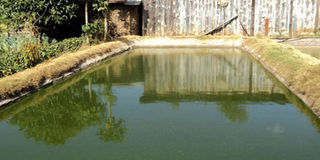Slurry: The rich by-product with many practical uses

Slurry, the by-product of biological reactions occurring during the digestion of organic matter in a biogas unit. This by-product has varied uses. FILE PHOTO | NMG
What you need to know:
- It can be used as a fertiliser, in fish production, and in manufacture of animal feeds.
- It does not retain the smell of dung nor does it attract flies.
- For biogas owners who do not have enough land for cultivation, slurry can be drained of excess water, dried singly or composted with other organic waste and transported for use in a far off place.
- Slurry as feed for pigs, cattle and sheep has been shown on experimental basis to increase production.
The biological reactions occurring during the digestion of organic matter in a biogas unit reduce the contents of waste materials by 30-60 per cent and produce stabilised product (slurry) which can be used as a fertiliser or soil conditioner.
Farmers use a lot of money to purchase inorganic fertilisers but owners of biogas plants can substitute, complement or replace the inorganic fertiliser with slurry.
This is because the organic matter is broken down to nitrogen, phosphorus and potassium (NPK), a common fertiliser in the market.
Slurry has gained momentum not only due to the search for organic fertilisers but also because of its twin benefit of providing fertiliser and water.
Slurry from the cattle dung is used as a fertiliser, generate algae in fish production, and manufacturing of animal feeds.
Slurry as fertiliser
Nitrogen from organic manure is extracted by bacteria from large organic molecules and transformed into smaller inorganic water soluble compounds.
This transformation is called mineralisation. During the digestion process in a biogas plant, part of the organic nitrogen is mineralised to ammonium and nitrate and thus may be taken up by the plants immediately. If ammonia is not dissolved in water it may escape as gas into the air.
Therefore, digested slurry has to be kept moist or covered by soil to preserve its fertiliser value. Another possibility is to compost the slurry together with other organic material.
During composting ammonia is bound again in organic form by bacteria and does not evaporate. Urine from the animals should also be collected and added to the dung before putting it in the digester as urine has high nitrogen content.
The volume of digested slurry is about twice as much as that of fresh dung due to the water dilution factor at a ratio of 1:1, water to animal dung.
Slurry must reach the crops without losing too much of its fertiliser value. Whenever possible, slurry should be distributed directly to the crop by gravity. The best way is use of irrigation channels.
Studies have shown that slurry can increase crop production by a big margin. Some examples include potatoes (30 per cent), maize (40 per cent) and brinjals (103 per cent). The application rate is 5-20 tonnes of slurry/ha. Higher concentrations have better results.
Contrary to expectation, slurry does not retain the smell of dung nor does it attract flies like other waste. This is because the digestion process has broken down the organic material into constituents such as nitrogen that plants require.
Another, myth about slurry is that it will burn crops in a similar way to the fresh or partially composted dung.
Damaging crops does not take place with slurry as what actually kills the plants with fresh manure is the heat and the ammonia that are released as dung decomposes, a reaction that takes place in the digester.
For biogas owners who do not have enough land for cultivation, slurry can be drained of excess water, dried singly or composted with other organic waste and transported for use in a far off place.
One way of doing this is channelling the slurry into a pit that has saw dust. The saw dust will absolve the water and dry the slurry. It is important to remember to cover the pit to avoid losing some of the nitrogen content of the fertilizer.
Slurry as fish feed/pond fertilizer
Studies have found slurry to compete favourably with commercial feeds in production of fish that feed on plants such as carp and tilapia.
This is because Slurry fertilises fish ponds with resulting growth of micro plants that serve as feed for such fish. Slurry also has nutrients and can also be consumed directly by fish.
The slurry can also be used to multiply worms that are fed to catfish and other non-plant feeders. To utilise slurry in fish pods, a farmer can distribute 0.3-0.4 litres/m2 (90-120 litres in the common small scale ponds of 300m2) of cow dung slurry in a fish pond.
This can be done weekly. It is important to note that unlike the dung that takes up oxygen when decomposing with a possibility of suffocating the fish, slurry is already decomposed and has no fish choking threat.
Slurry as feed for other animals/plaster material
Slurry as feed for pigs, cattle and sheep has been shown on experimental basis to increase production.
At farm level, pig and poultry feed can be made by mixing 1:1, slurry to maize bran. For the communities that use dung to plaster houses, slurry is a better alternative due to its fully decomposed status that does not attract vermin and pests.
A lot of research is still ongoing on proper utilisation of slurry from different animal sources especially the application rates on various crop species and fish feed for various animals.




